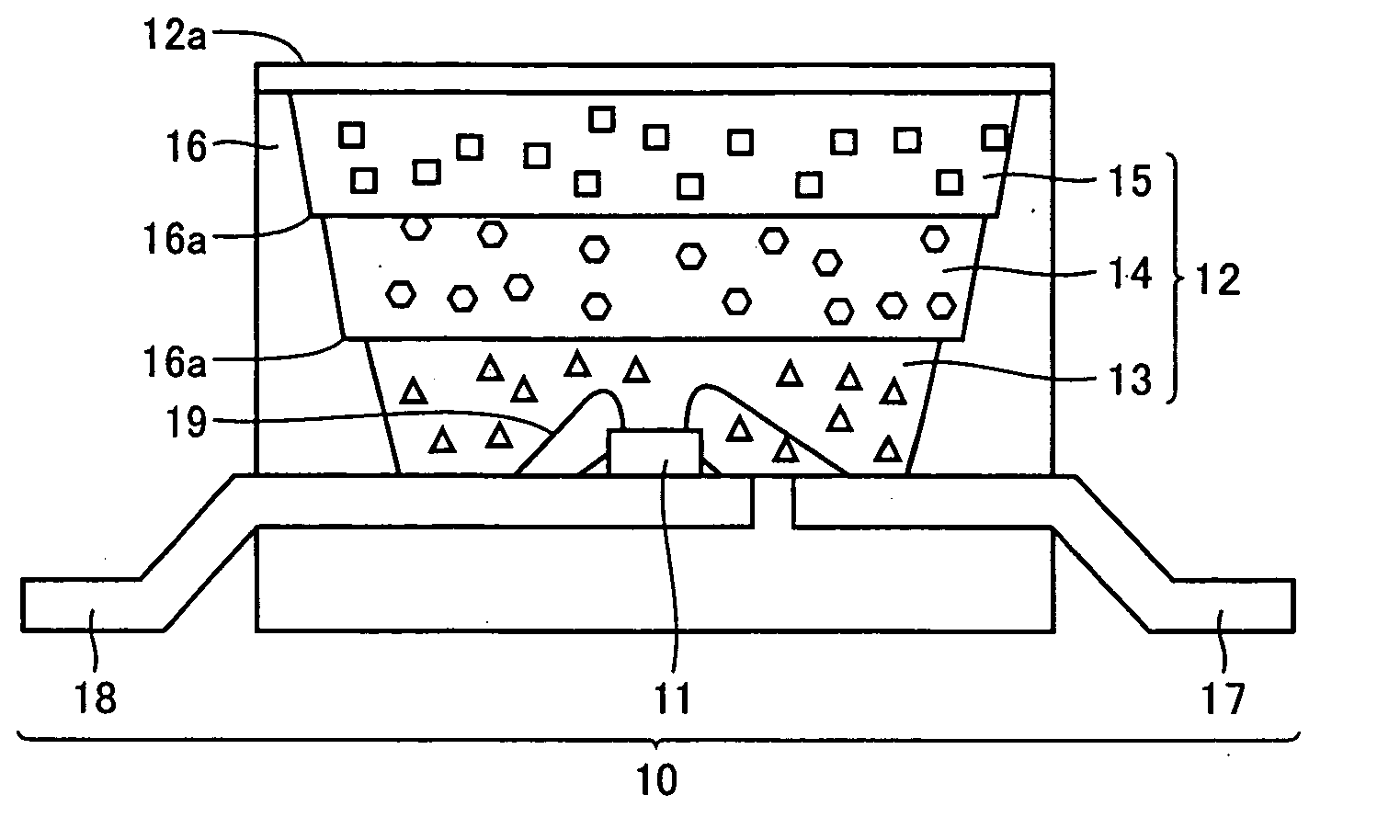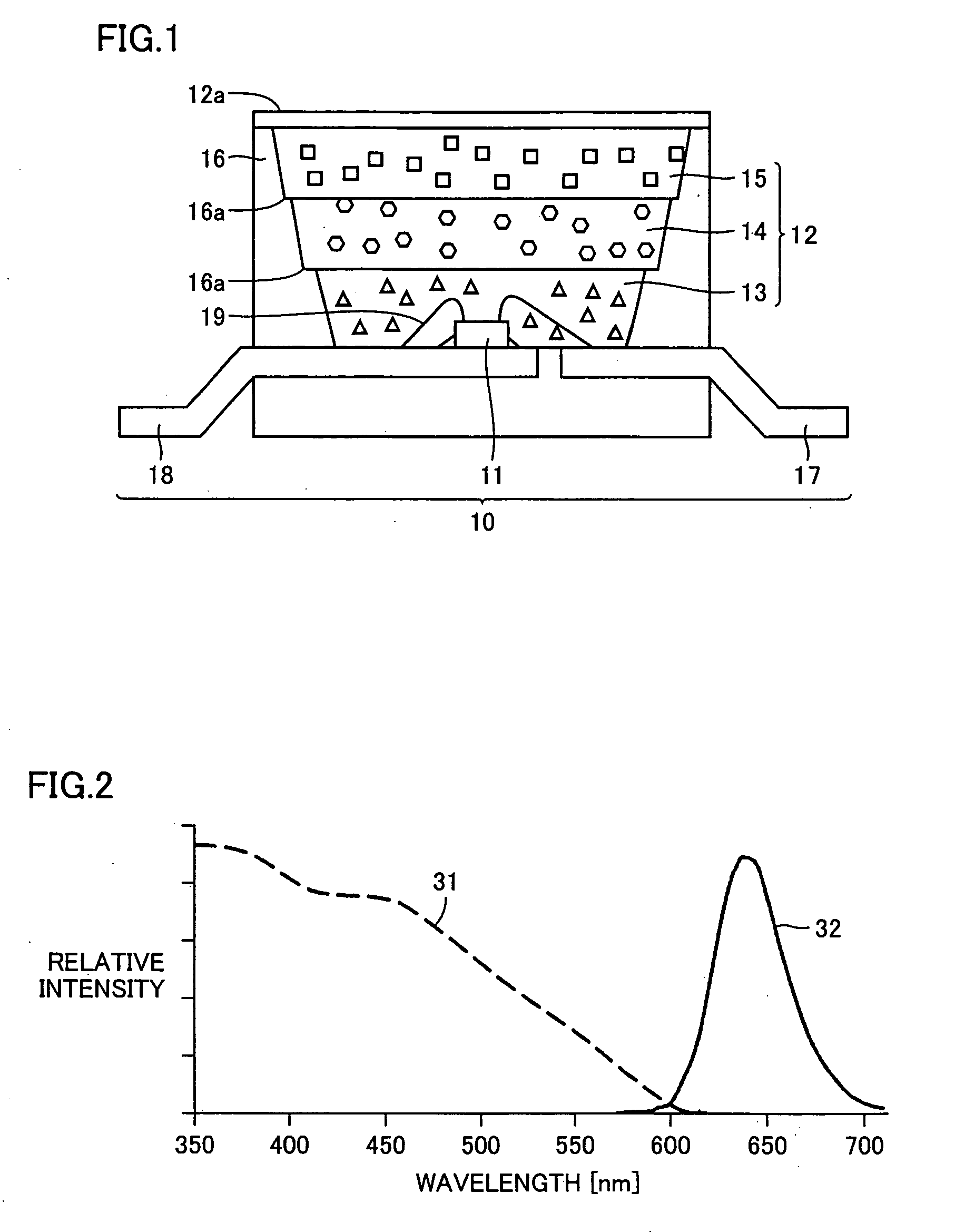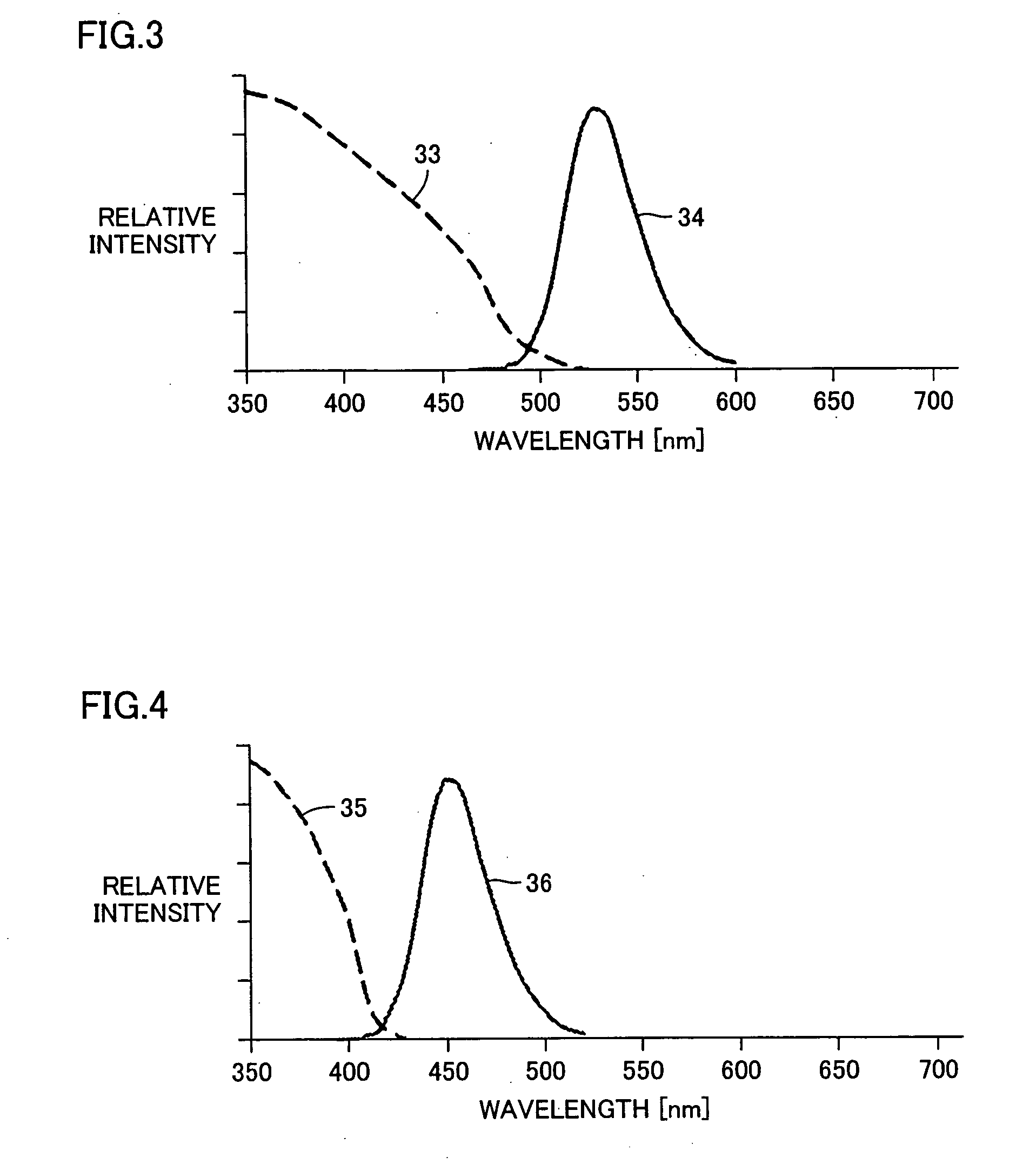Light emitting device and fabricating method thereof
a technology of light emitting device and fabrication method, which is applied in the direction of discharge tube/lamp details, discharge tube luminescent screen, discharge tube/lamp details, etc., can solve the problems of poor color reproducibility, no suggestion about an optimal combination, and inability to obtain a semiconductor light source having good luminous efficiency, etc., to achieve high luminance, easy color setting, and high efficiency
- Summary
- Abstract
- Description
- Claims
- Application Information
AI Technical Summary
Benefits of technology
Problems solved by technology
Method used
Image
Examples
example 1
[0049] In FIG. 1, a light-emitting device according to Example 1 of the present invention is illustrated in a schematic vertical cross sectional view. This light-emitting device 10 includes a light-emitting element 11 for emitting primary light, and a wavelength conversion unit 12 that absorbs at least part of the primary light and emits secondary light having a wavelength longer than that of the primary light. Light-emitting element 11 is mounted on a cathode terminal 18 and it is electrically connected to an anode terminal 17 and cathode terminal 18 via gold wires 19.
[0050] For light-emitting element 11, it is possible to use a gallium nitride (GaN)-based light-emitting diode having an emission peak wavelength at 410 nm, for example.
[0051] Wavelength conversion unit 12 includes a layer 13 that contains a phosphor having a composition of (Ca0.98Eu0.02)AlSiN3 for emitting red light, a layer 14 that contains a phosphor having a composition of (Ba0.85Eu0.15) (Mg0.80Mn0.20)Al10O17 fo...
example 2
[0064] In Example 2 of the present invention, a gallium nitride (GaN)-based light-emitting diode having a peak wavelength at 460 nm was used as the light-emitting element.
[0065] For the wavelength conversion unit, there were used a phosphor for green light represented by a composition of (Sr0.75Ba0.24Eu0.01)2SiO4 and a phosphor for red light represented by a composition of (Ca0.985Eu0.015)AlSiN3. It is recognized from FIG. 2 that the phosphor for red light can absorb green light (wavelength near 550 nm) emitted from the phosphor for green light and then can emit red light.
[0066] The light-emitting device of Example 2 was fabricated using the light-emitting diode and the phosphors, in a similar manner as in Example 1. As Comparative Example 2, there was fabricated a light-emitting device having a wavelength conversion unit formed of a single light-emitting layer made by mixing exactly the same kinds of phosphors as in Example 2.
[0067] Properties of the light-emitting devices of Ex...
examples 3-8
[0069] Light-emitting devices of Examples 3-8 and Comparative Examples 3-8 were fabricated in a similar manner as in Example 1 and Comparative Example 1, except that the emission peak wavelengths of the light-emitting elements and the kinds of phosphors used were changed. Evaluation results of their properties are shown in Table 3.
TABLE 3Peak wavelengthBrightnessof primary lightPhosphors(relative value)Tc-duvEx. 3410 nmred: (Ca0.94Sr0.05Eu0.01)AlSiN3100%6500 K − 0.003green: (Sr0.70Ba0.28Eu0.02)2SiO4blue: (Sr0.74Ba0.20Ca0.05Eu0.01)10(PO4)6.Cl2Com. Ex. 3″red: (Ca0.94Sr0.05Eu0.01)AlSiN3 73%″green: (Sr0.70Ba0.28Eu0.02)2SiO4blue: (Sr0.74Ba0.20Ca0.05Eu0.01)10(PO4)6.Cl2Ex. 4410 nmred: (Ca0.99Eu0.01)(Al0.90Ga0.10)SiN3100%7500 K + 0.001green: (Ba0.86Eu0.14)Mg0.75Mn0.25)Al10O17blue: (Ba0.86Eu0.14)(Mg0.99Mn0.01)Al10O17Com. Ex. 4″red: (Ca0.99Eu0.01)(Al0.90Ga0.10)SiN3 70%″green: (Sr0.70Ba0.28Eu0.02)2SiO4blue: (Sr0.74Ba0.20Ca0.05Eu0.01)10(PO4)6.Cl2Ex. 5450 nmred: (Ca0.98Eu0.02)AlSiN3100%5800 K ...
PUM
 Login to View More
Login to View More Abstract
Description
Claims
Application Information
 Login to View More
Login to View More - R&D
- Intellectual Property
- Life Sciences
- Materials
- Tech Scout
- Unparalleled Data Quality
- Higher Quality Content
- 60% Fewer Hallucinations
Browse by: Latest US Patents, China's latest patents, Technical Efficacy Thesaurus, Application Domain, Technology Topic, Popular Technical Reports.
© 2025 PatSnap. All rights reserved.Legal|Privacy policy|Modern Slavery Act Transparency Statement|Sitemap|About US| Contact US: help@patsnap.com



